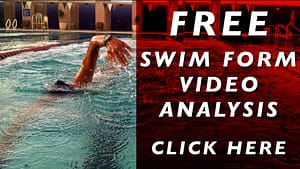Do triathletes need to strengthen their kick to become a better swimmer?
I discuss How to swim without kicking on the Endurance Hour YouTube channel.
When I was a swimmer K-college, my stroke technique encouraged me to use my kick for propulsion in coordination with my arms. As a swimmer, we incorporate kick sets in almost every practice. I was always the last swimmer in my lane because kicking was not my strength.
The first few years post-college when I continued to train for a triathlon, I changed my swim technique to maximize my upper body to propel me through the water using three muscle groups: latissimus dorsi, rear delts, and triceps. I learned to kick is for body balance, not propulsion.
When I coach triathletes to maximize their propulsion, first, I ensure that their breathing, body balance and kick is not causing drag which will compromise propulsion. Then I focus on their underwater pull which is composed of “The Catch” and “The Push”. The Catch engages your lats and rear delts and “The Push” activates your triceps.
Length of Swimming vs Triathlon Events
Looking at swimming events, 95% are less then 6 minutes, and swimmers don’t need to bike or run afterwards. Kicking is valuable for propulsion in a short swimming event relative to triathlon events, swim technique includes a higher vertical forearm and daily kick sets into their training programs.
Looking at triathlon events, the swim portion is 10 minutes to 2 plus hours. Triathletes also bike and run after they swim so the benefit of “saving their legs” is important.
Drawbacks to spending time kicking
Triathletes tend not to swim much, so adding kicking sets is not the most beneficial use of their time.
Kicking uses larger muscle groups and can create breathlessness and fatigue, requires a lot of oxygen to produce minimal propulsion. 5 Tips to control your breathing
Benefits from kicking
Triathletes have overdeveloped quads, tight hip flexors and inflexible ankles from biking and running. I encourage triathletes to kick with fins. This will keep their toes loosely pointed, quad and hip flexor engaged and legs on the surface of the water like a pull buoy can. Kicking with fins also promote ankle flexibility and leg recovery. Vertical kicking is also beneficial for body alignment and posture.
How do you get faster with swimming? Swimming is a technique, strength sport. Once you develop the technique with various balance, recovery, hand entry, catch and pull drills, then condition your body to become stronger with that technique by maximizing the amount of water you pull with every arm stroke, then increase your arm cadence without losing strength, distance per stroke, and you will come an efficiently, faster swimmer.
Kicking can compromise a triathletes propulsion if they kick wide, a.k.a split kick, kick with a big amplitude, bend knees too much or have flexed vs pointed toes. These things create improper balance and alignment and not assist in propulsion. Focus on stabilizing legs, keep ankles close together, narrow amplitude and soft and gentle to minimize drag. A proper kick initiated from your hip flexors and quads, and having flexible ankles, will allow your legs to stay on the surface of the water for body balance, it does not take much energy to achieve this. Since most triathletes will wear a wetsuit, you do not need to kick in a wetsuit.
The main purpose of the kick is freestyle is to provide body balance, not propulsion, especially for triathletes.
